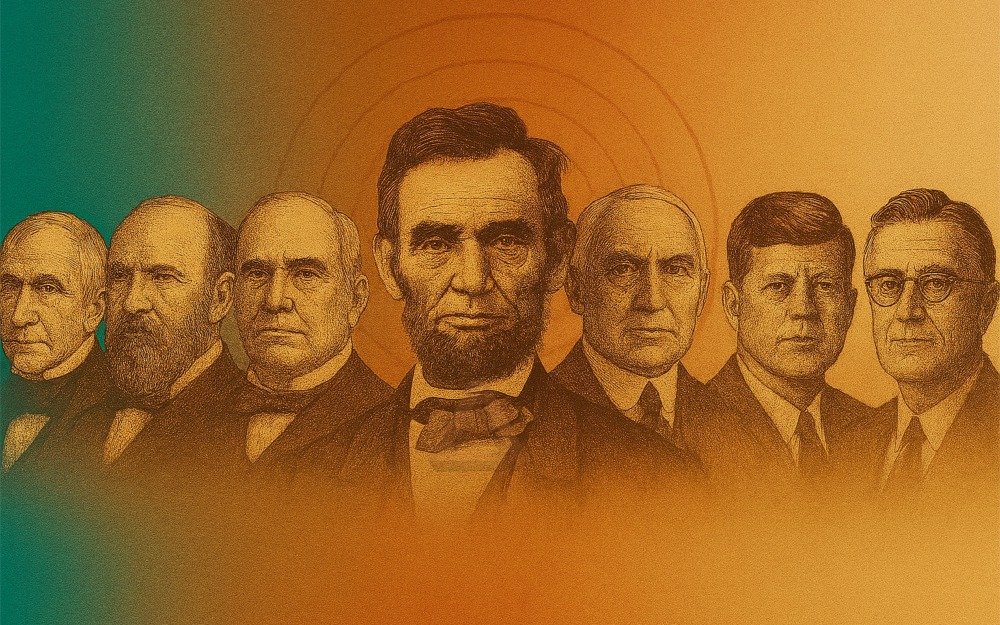
In 1811, William Henry Harrison led a preemptive strike against the Shawnee near the Tippecanoe River. The battle was short, violent, and decisive. Harrison returned with a reputation. “Old Tippecanoe,” they called him — a name that stuck through his presidential campaign nearly three decades later.
What followed wasn’t just political history. It was a pattern. Harrison, elected in 1840, died in office. So did Lincoln, Garfield, McKinley, Harding, Roosevelt, and Kennedy — each elected in a year ending in zero. The sequence became known as the Curse of Tippecanoe, or more broadly, the 20 Year Presidential Curse. Seven presidents. Seven deaths. All tethered to the same arithmetic. From Harrison in 1840 to Kennedy in 1960, the pattern held with eerie precision.
The Pattern Begins — The First to Fall: Harrison in 1841
William Henry Harrison, elected in 1840, died just 31 days into his term. The popular story is simple: he gave the longest inaugural address in history, stood bareheaded in cold rain, and caught pneumonia. But medical historians now question that sequence. Harrison’s symptoms — gastrointestinal distress, high fever, and delirium — align more closely with enteric fever, likely typhoid, contracted from contaminated water near the White House.
His death marked the first breach in the presidential line. It also set the arithmetic in motion. Elected in a zero year. Died in office. The pattern began.
Lincoln — The Pattern Deepens
Abraham Lincoln was elected in 1860 and assassinated five years later. The war had ended. The country was fractured. On April 14, 1865, Lincoln entered Ford’s Theatre to watch Our American Cousin. He never left. A single shot to the back of the head — fired by John Wilkes Booth — ended his presidency and deepened the pattern.
Lincoln’s death wasn’t just a national trauma. It was arithmetic. Elected in a zero year. Died in office. The second breach in presidential continuity.
Garfield — A Slow Death and a Bungled Response
James A. Garfield, elected in 1880, was shot just four months into his presidency. The bullet didn’t kill him outright. What followed was a slow decline — weeks of infection, failed interventions, and medical misjudgment. His doctors continually probed the wound with unsterilised instruments, searching blindly for the bullet and likely worsening the infection.
In a last-ditch effort, Alexander Graham Bell attempted to locate the bullet using an early metal detector. But Garfield lay on a bed with metal springs, and the device couldn’t distinguish the bullet from the frame beneath him. Garfield lingered through the summer, finally dying on September 19, 1881. The third breach.
McKinley — A Familiar Pattern, A Delayed Death
William McKinley, elected in 1900, was shot twice while greeting visitors at the Pan-American Exposition in Buffalo. The date was September 6, 1901. At first, doctors believed he would recover. The wounds were cauterised, and McKinley seemed stable. But gangrene set in. His condition worsened. He died eight days later.
His assassin, Leon Czolgosz, claimed to act in the name of anarchism. The public response was swift. The pattern, less so. McKinley’s death came not from immediate trauma, but from infection — again. Elected in a zero year. Died in office. The fourth breach.
Harding — No Autopsy, No Consensus
Warren G. Harding was elected in 1920. He died three years later in San Francisco, midway through a cross-country tour meant to restore public confidence. The official cause was heart failure. Some said stroke. His physicians disagreed. No autopsy was performed.
Harding had complained of stomach pain, fatigue, and shortness of breath. The press speculated. Poisoning was mentioned. So was stress. The Teapot Dome scandal was still unfolding. His death left questions. But the arithmetic held. Zero year. Died in office. The fifth breach.
Roosevelt — War, Strain, and a Private Collapse
Franklin D. Roosevelt secured a third term in 1940 and governed through global warfare during his fourth.
He was aging fast. The weight loss was visible. His blood pressure, dangerously high. He kept working — briefings, cables, negotiations. Churchill and Stalin were constant presences. The war was everywhere, and Roosevelt was in the middle of it.
On April 12, 1945, while sitting for a portrait in Warm Springs, Georgia, he collapsed. A cerebral hemorrhage. No warning. No recovery. He died shortly before Germany surrendered and Japan fell.
He passed away in the company of Lucy Mercer, his former mistress. The detail was withheld from early reports. There was no violence. No autopsy. Just a body worn down by war and years in office. Elected in a zero year. Died in office. The sixth breach.
Kennedy — A Motorcade, A Rifle, A Nation Stilled
John F. Kennedy was elected in 1960. He died three years later in Dallas, shot while riding in an open motorcade. The date was November 22, 1963. The footage is familiar. The rifle, traced to a sniper’s nest by an open window in the Texas School Book Depository; the accused: Lee Harvey Oswald.
Oswald was killed two days later. The Warren Commission named him the lone gunman. Others disagreed. The Zapruder film was dissected frame by frame. Conspiracies multiplied. The truth remains contested. But the arithmetic held. Elected in a zero year. Died in office. The seventh breach.
Reagan — Shots Fired, The Pattern Broken
Ronald Reagan won the presidency in 1980. In March 1981, he was shot outside a hotel in Washington, D.C. The bullet missed his heart by inches and punctured a lung. He was rushed into surgery and survived.
The shooter, John Hinckley Jr., claimed it was done to impress an actress. The motive was personal. The breach, incomplete. Reagan survived. The arithmetic broke. Elected in a zero year. Wounded in office. But he did not die. The pattern held. Until it didn’t.
🔗 Think that was strange? There’s more. Explore our full Oval Office Oddities archive.
References
[1] Miller Center, University of Virginia. William Henry Harrison: Death of the President. Retrieved September 2025.
[2] National Archives. Lincoln Assassination Report. Retrieved September 2025.
[3] Library of Congress. James A. Garfield Papers Collection. Retrieved September 2025.
[4] Wikipedia. Assassination of William McKinley. Retrieved September 2025.
[5] National Archives. Warren G. Harding Papers. Retrieved September 2025.
[6] FDR Presidential Library. Home – FDR Presidential Library & Museum. Retrieved September 2025.
[7] JFK Library. November 22, 1963: Death of the President. Retrieved September 2025.
[8] Reagan Presidential Library. Assassination Attempt on Reagan. Retrieved September 2025.
